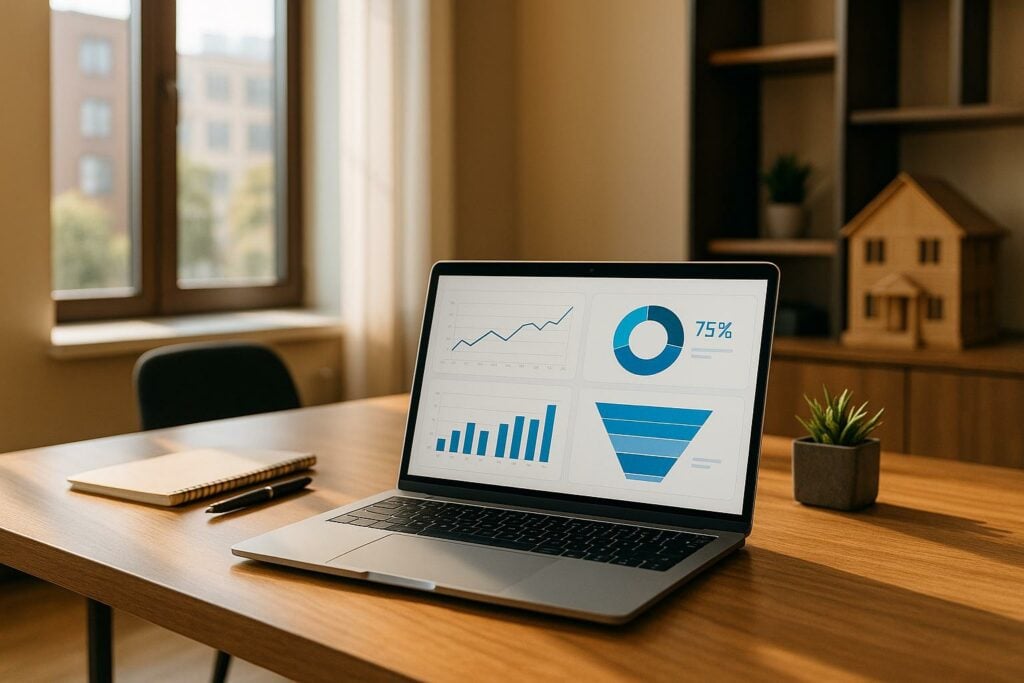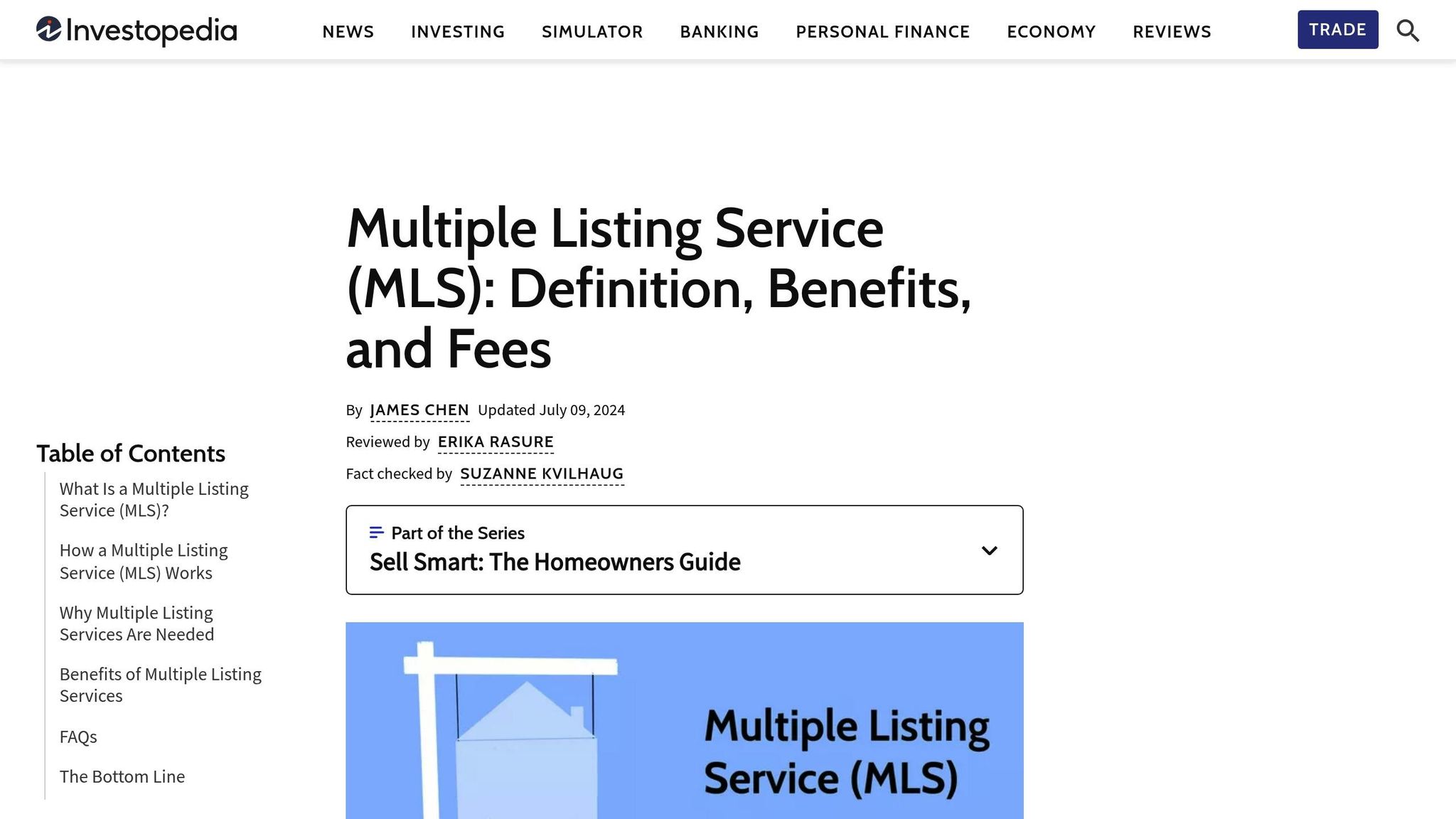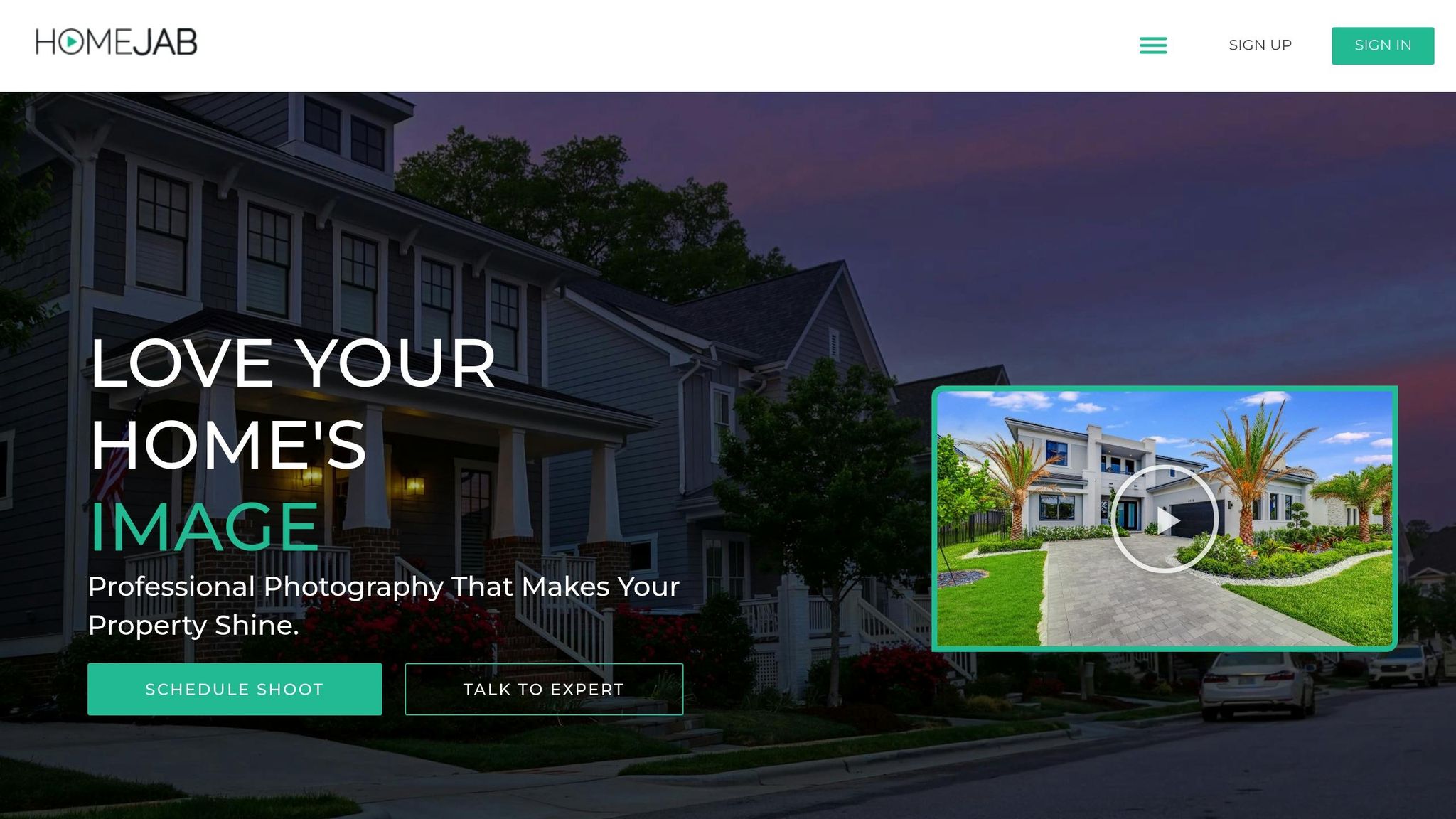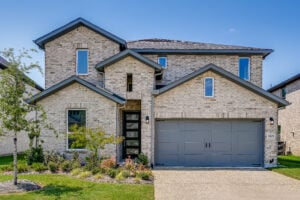Want to turn more property views into sales? Real estate conversion analytics is your answer. This guide dives into how tracking key metrics can help you understand buyer behavior, improve your listings, and close deals faster. Here’s what you’ll learn:
- Why conversion analytics matters: It helps pinpoint where potential buyers lose interest so you can adjust your strategy.
- Key metrics to track: From lead-to-client conversion rates to showing-to-offer ratios, these numbers reveal what works.
- How to improve listings: Professional photos, virtual tours, and better CTAs make your properties stand out.
- Tools to simplify tracking: CRMs, MLS integrations, and analytics dashboards streamline data collection and analysis.
Track These Numbers To Grow Your Closings From 12 to 20 Real Estate Deals Per Year
What Are Real Estate Conversion Rates
Real estate conversion rates help measure how well your marketing efforts turn potential buyers into actual clients. Think of it as the link between showcasing a property and motivating someone to take action – whether that’s making a phone call, scheduling a tour, or submitting an offer.
Unlike industries where a single click can seal the deal, real estate conversions often unfold over several steps and can take weeks or even months. A property listing might generate online views, lead to phone calls, result in showings, and eventually culminate in an offer. Each step provides valuable insight into how effectively your marketing strategy is working.
By tracking these rates, you can identify what’s working and what isn’t. For example, if professional photography leads to more inquiries, it’s a clear sign that investing in high-quality visuals pays off.
Real Estate Conversion Rate Basics
At its simplest, a real estate conversion rate is the percentage of people who take a specific action after engaging with your marketing materials or property listing. The calculation is straightforward: divide the number of actions (like inquiries or showings) by the total number of views, then multiply by 100 to get the percentage.
For instance, if a property listing gets a large number of views online and a portion of those viewers make phone inquiries, you can calculate a view-to-inquiry conversion rate. Similarly, if those inquiries lead to scheduled showings, you can track the inquiry-to-showing conversion rate.
Real estate agents usually monitor multiple stages of the process, such as:
- Lead generation: Measuring initial interest, like online views or inquiries.
- Qualification: Identifying serious buyers versus casual browsers.
- Closing: Turning qualified prospects into actual sales.
Different types of properties and price ranges tend to follow different conversion patterns. For example, luxury homes might see fewer inquiries upfront but have a higher conversion rate from showings to offers. On the other hand, starter homes might attract more inquiries but require additional showings to secure an offer. Recognizing these patterns helps set realistic expectations and ensures your efforts are focused where they’ll have the most impact.
These basics set the stage for understanding what influences conversion rates.
Key Factors That Impact Conversion Rates
Several factors play a role in how effectively prospects move through the sales funnel:
- Property presentation: High-quality photography, professional video tours, and detailed floor plans make listings stand out and attract serious buyers.
- Accurate pricing: A well-priced property generates more interest and showings, while mispricing can drive potential buyers away.
- Website and platform usability: A smooth, user-friendly experience is essential. Slow-loading images, incomplete contact details, or clunky inquiry forms can turn prospects off. Mobile optimization is especially critical.
- Response time: Quick follow-ups and the ability to schedule showings promptly keep prospects engaged and increase the likelihood of conversion.
- Market conditions and seasonality: Activity tends to peak during warmer months, but local economic trends can also influence buyer behavior.
Industry Standards and Benchmarks
Although benchmarks vary depending on the region, property type, and market conditions, there are some common metrics that agents use to gauge performance:
- Views-to-inquiries
- Lead-to-client conversions
- Showings-to-offer ratios
- Time-to-conversion
These benchmarks are useful as general guidelines rather than rigid goals. What defines strong performance will depend on your specific market, the type of properties you’re working with, and your target audience. By keeping these factors in mind, you can better evaluate and refine your strategies.
Key Metrics for Real Estate Conversion Analytics
Once you’ve got the basics down, it’s time to dive deeper into the numbers that truly matter. These metrics go beyond surface-level stats, offering meaningful insights into how well your real estate strategies are working. Focus on what drives results, not just the flashy figures.
Lead Conversion Rates and Listing Performance
Lead-to-client conversion rates reveal how effectively initial inquiries turn into paying clients. While conversion rates vary depending on factors like market conditions and lead sources, tracking this metric helps you understand how well you’re nurturing leads into signed deals.
Average days on market (DOM) is a critical measure of how quickly your listings attract serious buyers. High-quality media, like professional photos and virtual tours, can often reduce DOM. By monitoring this metric, you can identify trends across different property types and price ranges in your market.
Listing-to-sale ratios show the percentage of your listings that successfully close. A higher ratio usually means your pricing and marketing strategies are on point. If the ratio is lower, it might be time to rethink your pricing or improve how your properties are presented.
Price-to-list ratios track how closely final sale prices match the original listing prices. A strong ratio suggests effective pricing and marketing, while a lower ratio could point to issues with how the property was initially priced or marketed.
Engagement Metrics for Property Listings
Click-through rates (CTR) from search results to full listings measure how well your headlines and visuals grab attention. If your CTR is low, it might be time to rethink your listing headlines or invest in better visuals.
Time spent on listing pages shows how engaged potential buyers are. Listings with features like virtual tours, detailed descriptions, and multiple high-quality images tend to hold attention longer, increasing the likelihood of inquiries.
Bounce rates indicate how quickly visitors leave your listing pages. High bounce rates could signal problems like slow loading times, poor-quality images, or incomplete property details. Optimizing your pages – especially for mobile viewing – can help keep visitors engaged.
Social sharing rates track how often your listings are shared on platforms like Facebook or Instagram. Listings with dynamic elements, such as drone footage or interactive tours, are more likely to be shared, extending their reach to a broader audience.
Inquiry-to-showing conversion rates measure how many inquiries turn into scheduled property visits. High conversion rates here often reflect strong communication and efficient scheduling, while lower rates might highlight areas where improvement is needed.
Next, let’s explore metrics that focus on agent and team performance.
Agent and Team Performance Metrics
Beyond property-specific metrics, tracking agent and team performance offers another layer of insight into your overall success.
Response time metrics matter throughout the entire sales process. Quick responses can significantly boost conversion rates. By tracking response times across email, phone, and other channels, you can pinpoint where to improve.
Follow-up consistency ensures that leads are nurtured effectively over time. A structured follow-up system reduces the risk of losing potential clients to competitors.
Showing-to-offer conversion rates provide a snapshot of how well your in-person efforts are working. A high rate suggests strong preparation and buyer qualification, while a lower rate might indicate areas for improvement, such as staging or communication during showings.
Client satisfaction scores from surveys help gauge the likelihood of referrals and repeat business. High satisfaction often leads to more word-of-mouth marketing and a steady stream of loyal clients.
Average commission per transaction gives insight into your profitability. When paired with transaction volume, this metric helps you evaluate whether your business model is working. For higher-value transactions, investing in professional marketing materials often pays off.
Pipeline velocity measures how quickly prospects move from initial inquiry to closing. A faster pipeline often reflects effective qualification, responsive communication, and strong listing presentations.
These metrics provide a solid foundation for strategies to improve conversion rates, which we’ll cover later in this guide.
Tools and Methods for Tracking Real Estate Conversions
Modern tools offer invaluable insights that can turn marketing strategies into successful deals.
CRM Systems and Analytics Dashboards
Customer Relationship Management (CRM) systems are essential for tracking conversions in real estate. These platforms centralize client interactions – from initial inquiries to final closings – making it easy to trace where leads originate and how they move through your sales funnel.
CRMs automatically log lead sources, whether they come from your website, social media, referrals, or paid ads. This helps identify which channels bring in the most promising prospects. Top-tier CRMs also track response times, follow-up schedules, and communication preferences, giving you practical insights into what resonates with different clients.
Analytics dashboards within these systems provide real-time data on your performance. You can quickly check how many leads you’ve generated, your showing-to-offer conversion rate, and which properties are drawing the most attention. Many CRMs let you customize dashboards to focus on the metrics that matter most to your business.
Automation within CRMs ensures consistent follow-ups through scheduled emails, reminders, and response tracking. This minimizes the risk of missing opportunities and helps maintain strong client relationships.
Additionally, CRMs can integrate with your MLS and marketing tools, offering a comprehensive view of the client journey. This integration allows you to leverage detailed MLS data for even deeper insights.
MLS Data and Integration Tools
Taking CRM capabilities a step further, Multiple Listing Service (MLS) data integration refines your understanding of property performance and market trends. When connected to your analytics tools, MLS data can uncover patterns that boost your conversion rates.
MLS integration tools provide insights into which property features attract inquiries, how pricing impacts showings, and which neighborhoods are most effective at converting leads.
Automated data synchronization ensures your listings are always up-to-date across platforms without requiring manual updates. When you update property details, photos, or statuses in the MLS, these changes automatically reflect on your website, social media, and marketing materials. This keeps your information consistent and professional, preventing any potential confusion for buyers.
Market analysis tools that incorporate MLS data help you compare your performance against local trends. You can assess how your average days on market stack up against similar properties, evaluate pricing strategies, and identify which listing approaches work best for different price ranges.
Opt for integration tools that align with your workflow. The most effective platforms reduce manual data entry while providing valuable insights into how market conditions influence your results.
Media Improvements for Better Analytics
High-quality visuals are more than just eye-catching – they drive engagement and provide actionable data. Listings with professional media see 87% more views, sell 31% faster, and can command up to 9% higher prices.
Professional photography and HDR imaging are the foundation of standout listings. These visuals not only attract attention but also generate trackable data. You can analyze which photos get the most clicks, how long viewers spend on each image, and which elements drive inquiries.
3D virtual tours and video content offer even richer analytics. These tools reveal which rooms capture the most interest, how long viewers engage, and where attention starts to drop off. This insight helps you pinpoint the features that matter most to buyers.
Virtual staging is a cost-effective way to elevate property presentation while gathering useful data. For around $50 per photo, you can test staged versus unstaged images to determine which approach generates more inquiries and longer engagement times.
Aerial photography and drone footage provide unique perspectives while offering insights into exterior features that draw attention. Analytics often show that properties with compelling aerial views receive more social shares and longer viewing times.
Professional media services, such as HomeJab, combine high-quality visuals with detailed analytics. With services like HDR photography, 3D tours, and aerial footage delivered in just 24 hours, you can quickly experiment with different visual strategies and measure their impact on your conversion metrics.
The built-in tracking tools offered by these media platforms allow you to see how visual upgrades influence engagement. For example, you can compare the performance of standard photos versus HDR images or analyze how virtual tours stack up against static visuals across various price points and property types.
sbb-itb-82c5f45
Proven Methods to Boost Conversion Rates
Building on the key metrics discussed earlier, these strategies are designed to improve listing performance and engage potential clients effectively. Turning property views into tangible leads and sales requires a mix of compelling visuals, user-friendly design, and trust-building tactics. Successful real estate professionals know that these elements, when combined strategically, can significantly boost conversion rates.
Improving Listings with Professional Media
High-quality visuals can make a dramatic difference in how a listing performs. For example, professional photography has been shown to reduce sales time by 32%, while virtual tours can generate 87% more views, leading to increased inquiries and faster sales. These tools don’t just enhance the look of a listing – they directly impact its success.
Using HDR photography is another effective way to elevate your listings. This technique captures a broader range of details, from bright outdoor spaces to well-lit interiors, creating images that are visually striking and can increase views by up to 61%. The result? Photos that immediately grab attention and stand out in a crowded market.
Video walkthroughs and interactive 3D tours offer even more immersive experiences. Videos guide buyers through the layout of a property, while 3D tours let them explore at their own pace. These formats not only keep viewers engaged longer but also encourage social sharing, expanding your reach.
Virtual staging is an affordable alternative to traditional staging, costing about $50 per photo. It allows you to experiment with different design styles to see what resonates with your audience. You can even stage a single room in multiple ways to determine which version generates the most interest.
Tools like HomeJab make it easy to access professional media services, offering HDR photography, 3D tours, aerial shots, and virtual staging with a quick turnaround. Their streamlined process ensures consistent quality, allowing you to test and measure the impact of various visual strategies on your listings.
Think of professional media as an investment, not an expense. Track metrics like time spent on listing pages, inquiry rates, and social shares before and after implementing these upgrades to evaluate their effectiveness. Once your visuals draw attention, the next step is optimizing your calls to action (CTAs).
Optimizing Calls to Action and Landing Pages
Well-placed, action-oriented CTAs can significantly boost lead capture rates. Instead of generic phrases like "Contact Us", use specific and engaging prompts such as "Schedule a Private Tour", "Request Property Details", or "Get Instant Market Updates." These targeted messages guide potential clients toward taking the next step.
Position your primary CTAs above the fold – where they’re immediately visible without scrolling. This prime spot ensures your most important conversion opportunities aren’t missed. Adding secondary options like "Save This Property" or "Share with Family" can also appeal to buyers at different stages of interest.
For landing pages, simplicity is key. Pages should load in under 4 seconds, be mobile-friendly, and focus on a single conversion goal to avoid distractions. Keep lead capture forms straightforward by asking for only essential details like name, email, and phone number. Additional information can be gathered during follow-up interactions.
To fine-tune your CTAs, use A/B testing. Experiment with different colors, text, and placements to determine what resonates most with your audience. These small adjustments can lead to noticeable improvements in lead generation.
Using Social Proof and Testimonials
Social proof is a powerful way to build trust and credibility. Incorporating client testimonials – both written and video – can validate your expertise and market performance. Highlight specific achievements, such as "sold 47 homes in the past 12 months", to provide concrete evidence of your success. Including testimonials on your website can increase conversion rates by up to 34%.
Showcasing recent sales is another effective method. Display properties you’ve sold, along with key details like sale prices, days on market, and notable achievements (e.g., selling above the asking price). This demonstrates your active presence in the market and reinforces your capabilities.
Video testimonials can be particularly impactful. Simple, authentic recordings of satisfied clients sharing their experiences can resonate deeply with potential buyers. Keep these videos short – 30 to 60 seconds – and focus on the specific benefits you provided.
Integrating reviews from platforms like Google, Zillow, and Facebook adds further credibility. Don’t just display star ratings; include excerpts from detailed reviews that highlight your strengths. Regularly updated reviews signal ongoing client satisfaction and a thriving business.
Before-and-after stories are another compelling way to showcase your skills. Document how your strategies – like professional photography, staging, or pricing – transformed a challenging listing into a successful sale. These case studies not only highlight your problem-solving abilities but also demonstrate the tangible results you can deliver.
Analyzing and Optimizing Conversion Performance
Once you’ve polished your media, fine-tuned your CTAs, and built up social proof, the next step is to focus on measuring and improving your results. Conversion optimization isn’t a one-and-done task – it’s an ongoing process of tracking, testing, and tweaking.
Using A/B Testing for Listing Improvements
A/B testing is a powerful way to figure out what works best. By comparing two versions of a listing element, you can see which one resonates more with potential buyers. Start with high-impact elements like the main photo, headline, or primary CTA, and test them one at a time.
For example, you could test an exterior shot against an interior image to see which one grabs more attention. Run each version for a couple of weeks and track metrics like click-through rates, time spent on the listing, and inquiry submissions.
When testing headlines, you might compare a straightforward, descriptive one with another that focuses on buyer benefits. For instance, one headline could list property specs, while the other highlights unique features or move-in readiness.
You can also experiment with button text and colors. Does "Contact Agent" perform better than "Schedule Your Tour Today"? What about the placement of virtual tour links? Some agents find placing the 3D tour link near the top boosts engagement, while others notice better results when it follows the photo gallery. Use the data from these tests to build a playbook of strategies tailored to your market and property types.
Segmenting Analytics for Targeted Optimization
Once you’ve tested individual elements, dig deeper into the data by breaking it down into segments. This helps you spot patterns that might otherwise go unnoticed. Consider segmenting based on factors like property price range, location, type, and buyer demographics.
For example, higher-priced properties might benefit from video content and virtual tours, as buyers often take longer to make decisions. On the other hand, first-time homebuyers may respond better to listings that include educational content and generate faster inquiries.
Geographic segmentation can also guide your approach. Listings for urban condos might perform well with lifestyle-focused descriptions, while suburban family homes could benefit from emphasizing school districts and local amenities.
Segmenting by property type can help you decide where to invest in media. Single-family homes might see a boost from aerial photography, while condos could benefit more from detailed staging and floor plans. Townhomes might shine with virtual tours that show off the layout and flow.
Seasonal trends are another layer to consider. Spring listings might attract more interest in virtual tours, while summer buyers could be drawn to outdoor photos showcasing landscaping and entertainment spaces. Keeping detailed tracking sheets for each segment can help you spot trends over time and allocate resources more effectively.
Setting Actionable Goals Based on Data
With segmented insights in hand, it’s time to set clear, measurable goals. Start by establishing baseline metrics for your current performance, then set achievable targets based on industry standards and your past data.
Your goals should be specific and time-bound. Instead of saying, "We want more inquiries", aim for something like, "Increase inquiries by 15% over the next three months" or "Reduce average days on market by 10% this quarter." These kinds of goals make it easier to track progress and adjust your strategies.
Set benchmarks for engagement, too. For instance, ensure that professional photos consistently generate more views than standard images, or that virtual tours keep users engaged for a meaningful amount of time. If these benchmarks aren’t met, it might be time to revisit the quality or placement of your content.
Don’t forget about lead quality. Track how many inquiries turn into showings and, ultimately, into offers. If you’re getting lots of inquiries but few serious buyers, consider refining your targeting or adding more detailed property information to attract qualified leads.
Make it a habit to review your metrics regularly – whether monthly or quarterly. Compare your current performance to past results and industry averages to identify areas for improvement. If something isn’t working, dig into the data to figure out why. It could be anything from a technical issue to poor content placement.
Use tools like the HomeJab analytics dashboard to monitor performance across different property types. This data can guide your decisions on how to improve future listings and make the most of your media budget.
Finally, schedule regular strategy reviews – quarterly is a good starting point. These sessions allow you to assess which goals you’ve met, where you’ve fallen short, and how to adapt to changing market trends and buyer behaviors. Regular evaluations keep your optimization efforts aligned with the ever-shifting real estate landscape.
Conclusion: Mastering Real Estate Conversion Analytics
Conversion analytics isn’t just about crunching numbers – it’s about understanding buyer behavior and using that insight to create more effective property listings. Real estate agents who combine data-driven strategies with high-quality media consistently outperform those who rely on guesswork.
Key Takeaways for Real Estate Professionals
Top-performing agents treat conversion analytics as an ongoing process, not a one-and-done task. Each listing provides valuable data to refine strategies, and the core principles hold true across markets and property types. High-quality media draws attention, clear calls to action spark inquiries, and consistent testing uncovers what works best for your audience.
Here’s the proof: professional photography can boost online views by up to 118%, help properties sell 30% faster, and even increase sale prices by 32%. Adding professional video further amplifies engagement and inquiries. As previously highlighted, metrics like lead conversion rates and time on market improve significantly with strategic visual upgrades.
Focus on the metrics that truly matter – such as lead conversion rates, time on market, and the quality of inquiries. Avoid distractions like total view counts, especially if those views don’t translate into genuine buyer interest. Tailor your approach to the property type and price point. For instance, luxury listings may benefit from complete media packages, while starter homes might see the best results with high-quality photos and virtual staging.
By combining data insights with top-notch media, agents can consistently transform interest into offers. These strategies naturally lead to actionable steps for leveraging advanced media solutions.
Taking the Next Steps with HomeJab
To turn these insights into tangible results, consider working with a service that simplifies professional media production. Bridging the gap between data and action requires the right tools, and HomeJab offers a comprehensive suite of on-demand professional media services designed to boost conversions.
With a network of vetted local professionals and 24-hour turnaround times, HomeJab makes it easy to include professional media in every listing. Start by benchmarking your current conversion rates, enhance your listings with professional media, and track the improvements. Many agents notice measurable gains within just a few listings, and over time, these small wins build a reputation for excellence.
Your journey with conversion analytics will evolve as you learn what resonates with buyers in your market. Agents who embrace this process don’t just sell properties faster – they establish themselves as leaders in an increasingly visual and competitive industry.
FAQs
How can real estate agents use conversion analytics to enhance their sales strategies?
Real estate agents have a powerful tool at their disposal: conversion analytics. By diving into metrics like lead behavior, website traffic, and how users interact with their content, agents can pinpoint which prospects are most likely to make a move. This means they can focus their time and energy on the opportunities that matter most.
Paying attention to data points like page views, bounce rates, and engagement trends can make a big difference. For example, understanding how users navigate property listings or interact with marketing materials allows agents to fine-tune their approach. The result? A more seamless experience for potential buyers and sellers. By using this data-driven strategy, agents can not only nurture leads more effectively but also make smarter decisions that ultimately drive better sales results.
What are the top mistakes to avoid when tracking real estate conversion rates?
When keeping tabs on real estate conversion rates, there are a few common missteps that can throw off your progress. Here’s what to watch out for:
- Chasing vanity metrics: Numbers like "time on site" or "page views" might seem impressive at first glance, but they often don’t tell the full story. Instead, zero in on metrics that actually matter – like conversion rates, how quickly leads are being followed up on, and how users interact with crucial property details.
- Tracking metrics that don’t match your goals: Your data should serve your business objectives. For instance, make sure you’re using consistent date ranges across all your key performance indicators (KPIs). Inconsistent tracking can lead to skewed results and misinformed decisions.
- Overlooking data accuracy: If your tracking setup is flawed or your data collection isn’t consistent, it can lead to unreliable insights. And unreliable insights? They’ll steer your marketing strategies in the wrong direction.
By focusing on metrics that align with your goals and ensuring your data is accurate, you’ll be in a much better position to refine your marketing approach and get better results from your property listings.
How do professional photography and virtual tours improve real estate conversion rates?
Professional media services, like top-tier photography and virtual tours, can significantly boost real estate conversion rates by making property listings more appealing and engaging. Eye-catching photos grab attention, while virtual tours offer an immersive experience that allows buyers to picture themselves living in the space. The result? More inquiries and quicker sales.
Listings featuring professional photos tend to attract more serious buyers and sell faster. Virtual tours, meanwhile, give potential buyers the convenience of exploring a property online, saving time and building confidence in their decision-making process. When combined, these tools enhance a property’s online presence, sparking greater interest and driving stronger results.













